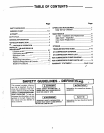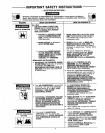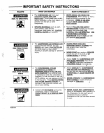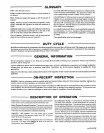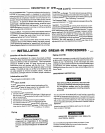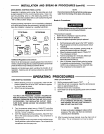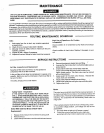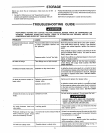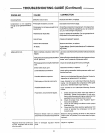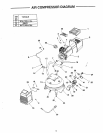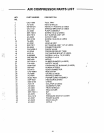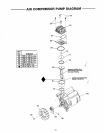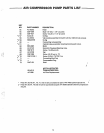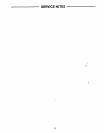
GLOSSARY
CFM: Cubic feet per minute.
or air tool. When the tank pressure drops
to
a certain level the
motor will restart automatically.* The pressure
at
which the
motor automatically re-starts
is
called "cut-in pressure."
SCFM:
Standard cubicfeet per minute;
a
unit of measure of
air delivery.
PSIG: Pounds per square
inch
gauge; a unit of measure
of
pressure.
ASME:
American Society of Mechanical Engineers; made,
tested, inspected and registered to meet
the
standards of
ASME.
California Code: Units comply with California Code
462
(L)
(Z)/(M)
(2).
Specification/model label
is
on the side of the
tank on units that comply
with
California Code.
Cut-In
Pressure:
While the motor
is
off,
air tank pressure
drops as you continue to use your accessory
Cut-Out Pressure: When you turn on your air compressor and
it
begins to run, air pressure in the
air
tank begins to build.
It
builds to a certain high pressure before the motor automati-
cally
shuts
off
-
protecting your air tank from pressure higher
than
its
capacity. The high pressure
at
which
the motor shuts
off
is
called "cut-out pressure."
U.L.
Listed: Pr0ductswiththeU.L markarelisted by Underwrit-
ers Laboratories, Inc. (U.L.). Samples of these products have
been evaluated by
U.L.
and meet the applicable U.L standards
for safety.
*See specification chart on front page.
DUTY CYCLE
All Makita manufactured air compressors should be operated on not more than a
50%
duty cycle. This means an air compressor
that pumps air more than
50%
of one hour
is
considered misuse, because the air compressor
is
undersized for the required air
demand. Maximum compressor pumping time per hour
is
30 minutes.
GENERAL
INFORMATION
This air compressor requires no oil. Now you can enjoy
all
the benefits of having an air compressor without ever having to
purchase, add or change oil.
Your air compressor can be used for operating paint spray guns, air tools, caulking guns, grease guns, air brushy, sandblaster,
inflating tires and plastic toys, or spraying
weed killers, insecticides, etc. An air pressure regulator
is
supplied for these
applications.
Separate air transformers which combine the functions of air regulation and/or moisture and dirt removal should be used where
applica ble.
-
I
ON-RECEIPT
DAMAGE: Each air compressor outfit
is
carefully tested and checked before shipment. With improper handling, dahage may
Immediately upon arrival, check equipment for both concealed and visible damages to avoid expenses being incurred to correct
such problems. This should be done regardless of any visible signs of damage to the shipping container.
If
this
product was
shipped directly to you, report any damages to carrier and arrange for inspection of goods immediately.
L
result in transit and cause problems
in
compressor operation.
,!
DESCRIPTION
OF
OPERATION
Drainvalve: Thedrainvalveis locatedatthe baseoftheair tank
and is used to drain condensation at the end of each use.
Motor Thermal Overload Protector: The electric motor has an
automatic thermal overload protector. If the motor overheats for
any
reason,thethermaloverload
protectorwillshutoff themotor.
The motor must be allowed to
cool
before restarting.
ONlAUTO
-
OFF Switch: Turn this switch
ON
to provide
automatic power to the pressure switch and
OFF
to
remove
power at the end
of
each use.
Air Intake Filter: This filter is designed to clean air coming into
the pump. This filter must alwavs be clean and free from
obstructions. See "Maintenance".
Air Compressor Pump: To compress air, the piston moves Up
and down in the cylinder. On the downstroke, air is drawn in
through the air intake valve. The exhaust valve remains closed.
On the upstrokeofthe piston, airiscompressed. Theintakevalve
closes and compressed air is forced out through the exhaust
valve, through theoutlettube, through thecheckvalve and into the
air tank. Working air
is
not available until the compressor has
raised the airtank pressure above that required at the air outlet.
Checkvalve: When the air compressor
is
operating, the check
valve is "open", allowing compressed air to enter the air tank.
When the air compressor reaches "cut-out" pressure, the check
valve "closes", allowing air pressure to remain inside the airtank.
continued
rt
5




